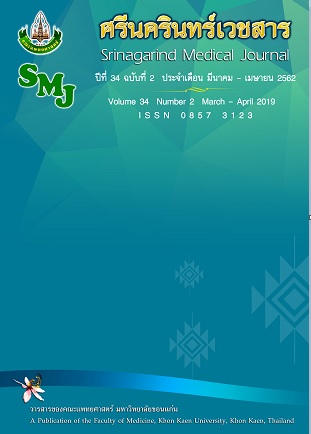Bile duct Injury During Cholecystectomy: Audit of 1,437 Laparoscopic and Open Cholecystectomy
Keywords:
Bile duct injury, การบาดเจ็บต่อท่อน้ำดีAbstract
การบาดเจ็บต่อท่อน้ำดีระหว่างผ่าตัดถุงน้ำดี: ทบทวนเวชระเบียนผู้ป่วย 1,437 ราย
เศรษฐบุตร เอื้อพานิชเจริญ
ภาควิชาศัลยศาสตร์ โรงพยาบาลมหาราชนครราชสีมา 49 ถ.ช้างเผือก ต.ในเมือง อ.เมือง จ.นครราชสีมา, 30000
หลักการและวัตถุประสงค์: การผ่าตัดถุงน้ำดีมีภาวะแทรกซ้อนที่สำคัญคือการบาดเจ็บต่อท่อน้ำดีระหว่างผ่าตัด ซึ่งทำให้เกิดผลเสียต่างๆในระยะยาวแก่ผู้ป่วย การศึกษานี้มีวัตถุประสงค์เพื่อทบทวนการผ่าตัดถุงน้ำดี ความชุกของการเกิดการบาดเจ็บต่อท่อน้ำดีในระหว่างผ่าตัด
วิธีการศึกษา: การศึกษาย้อนหลังจากเวชระเบียนของผู้ป่วยอายุ 18 ปีขึ้นไปที่มาผ่าตัดถุงน้ำดี ตั้งแต่วันที่ 1 มกราคม 2553 ถึงวันที่ 31 ธันวาคม 2557 ในโรงพยาบาลมหาราชนครราชสีมา
ผลการศึกษา: จากการศึกษา ผู้ป่วย 1,437 ราย พบความชุกของการบาดเจ็บท่อน้ำดีร้อยละ 1.32 โดยเกิดระหว่างการผ่าตัดแบบส่องกล้องมากกว่าผ่าตัดแบบเปิด แต่ไม่มีนัยสำคัญทางสถิติ (p=0.08) ผู้ป่วยที่มีการบาดเจ็บต่อท่อน้ำดีส่วนใหญ่ได้รับการวินิจฉัยระหว่างผ่าตัด หรือภายใน 14 วันหลังผ่าตัด ค่าใช้จ่ายรวมเพิ่มขึ้นจากกลุ่มที่ไม่มีการบาดเจ็บต่อท่อน้ำดีอย่างมีนัยสำคัญทางสถิติ (31,131.00 และ 65,806.05 บาท, p = 0.01) รวมทั้งระยะเวลาการนอนโรงพยาบาลมากกว่ากลุ่มที่ไม่มีการบาดเจ็บอย่างมีนัยสำคัญทางสถิติ ในการศึกษานี้ไม่มีผู้ป่วยที่เกิดการบาดเจ็บต่อท่อน้ำดีเสียชีวิต
สรุป: จากการศึกษานี้พบว่าการบาดเจ็บต่อท่อน้ำดีระหว่างผ่าตัดถุงน้ำดีมีความชุก 1.32% โดยพบระหว่างการผ่าตัดแบบส่องกล้องมากกว่าการผ่าตัดแบบเปิด แต่ไม่มีนัยสำคัญทางสถิติ (p=0.08) การเกิดการบาดเจ็บต่อท่อน้ำดีระหว่างผ่านตัดส่งผลให้เพิ่มระยะเวลาการนอนโรงพยาบาล มีค่าใช้จ่ายเพิ่มมากขึ้น และในบางรายต้องได้รับการผ่าตัดซ้ำเพื่อแก้ไขภาวะดังกล่าว
Background and objective: Cholecystectomy is a common procedure, but bile duct injury is serious problem. This injury causes several consequences such as longer hospital stays and increase cost of treatment and re-operation. This study aimed to investigate the prevalence of bile duct injury during cholecystectomy.
Method: Retrospective review of medical records of patients age more than 18-year-old underwent cholecystectomy between 1st January 2010 and 31st December 2014 at Maharat Nakhon Ratchasima hospital.
Results: From 1,437 patients in this study, 1.32% prevalence of bile duct injury was found. The injury occurred during laparoscopic cholecystectomy more common than open cholecystectomy but without statistical significant (p=0.08). Most of patients with bile duct injury were diagnosed during surgery or during first 2 weeks after the operation. Mean cost of treatment is significant higher in bile duct injury group than non-injury group (31,131.00 vs 65,806.05 baht, p = 0.01) and hospital length of stay also significantly longer. There was no mortality in bile duct injury group.
Conclusion: The prevalence of bile duct injury in this study was 1.32% which occur in laparoscopic cholecystectomy higher than open cholecystectomy but no statistical significance (p=0.08). This leads to longer hospital stay, higher mean cost of treatment and some patients needed to re-operation.
References
Karvonen J, Salminen P, Grönroos JM. Bile duct injuries during open and laparoscopic cholecystectomy in the laparoscopic era: alarming trends. Surg Endosc 2011; 25: 2906–10.
Richardson MC, Bell G, Fullarton GM. Incidence and nature of bile duct injuries following laparoscopic cholecystectomy: an audit of 5913 cases. West of Scotland Laparoscopic Cholecystectomy Audit Group. Br J Surg 1996; 83: 1356–60.
Strasberg SM, Hertl M, Soper NJ. An analysis of the problem of biliary injury during laparoscopic cholecystectomy. J Am Coll Surg 1995; 180: 101–25.
Roslyn JJ, Binns GS, Hughes EF, Saunders-Kirkwood K, Zinner MJ, Cates JA. Open cholecystectomy. A contemporary analysis of 42,474 patients. Ann Surg 1993; 218: 129–37.
Lim SH, Salleh I, Poh BK, Tay KH. Laparoscopic cholecystectomy: an audit of our training programme. ANZ J Surg 2005; 75: 231–3.
Flum DR, Cheadle A, Prela C, Dellinger EP, Chan L. Bile Duct Injury During Cholecystectomy and Survival in Medicare Beneficiaries. JAMA 2003; 290: 2168–73.
Rystedt JML, Montgomery AK. Quality-of-life after bile duct injury: intraoperative detection is crucial. A national case-control study. HPB 2016; 18: 1010–6.
Landman MP, Feurer ID, Moore DE, Zaydfudim V, Pinson CW. The long-term effect of bile duct injuries on health-related quality of life: a meta-analysis. HPB (Oxford) 2013; 15: 252–9.
Davidoff AM, Pappas TN, Murray EA, Hilleren DJ, Johnson RD, Baker ME, et al. Mechanisms of major biliary injury during laparoscopic cholecystectomy. Ann Surg 1992; 215: 196–202.
Flum DR, Koepsell T, Heagerty P, Sinanan M, Dellinger EP. Common bile duct injury during laparoscopic cholecystectomy and the use of intraoperative cholangiography: adverse outcome or preventable error? Arch Surg Chic Ill 1960 2001; 136: 1287–92.
Mahatharadol V. Bile duct injuries during laparoscopic cholecystectomy: an audit of 1522 cases. Hepatogastroenterology 2004; 51: 12–4.
Pariani D, Fontana S, Zetti G, Cortese F. Laparoscopic Cholecystectomy Performed by Residents: A Retrospective Study on 569 Patients. Surg Res Pract 2014; 2014: 1–5.
Pekolj J, Alvarez FA, Palavecino M, Sánchez Clariá R, Mazza O, de Santibañes E. Intraoperative management and repair of bile duct injuries sustained during 10,123 laparoscopic cholecystectomies in a high-volume referral center. J Am Coll Surg 2013 ; 216: 894–901.
Grace P A, Quereshi A, Coleman J, Keane R, McEntee G, Broe P, et al. Reduced postoperative hospitalization after laparoscopic cholecystectomy. Br J Surg 2005; 78: 160–2.
Rubert CP, Higa RA, Farias FVB. Comparison between open and laparoscopic elective cholecystectomy in elderly, in a teaching hospital. Rev Col Bras Cir 2016; 43: 2–5.
Ko-Iam W, Sandhu T, Paiboonworachat S, Pongchairerks P, Chotirosniramit A, Chotirosniramit N, et al. Predictive Factors for a Long Hospital Stay in Patients Undergoing Laparoscopic Cholecystectomy. Int J Hepatol 2017; 2017: 5497936.


